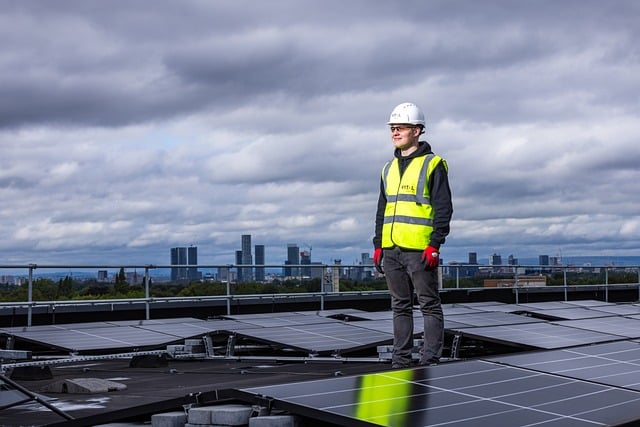“Unlocking Solar Savings: A Breakdown of Solar Inverter Costs for Every Budget!”
The cost of a solar inverter is a crucial factor in the overall expense of a solar energy system. Solar inverters, which convert the direct current (DC) generated by solar panels into alternating current (AC) for use in homes and businesses, come in various types and sizes, each with different price points. On average, the cost of solar inverters can range from $1,000 to $3,000, depending on the inverter type—string inverters, microinverters, or power optimizers. Additionally, installation costs, warranty options, and brand reputation can further influence the final price. Understanding these factors is essential for homeowners and businesses looking to invest in solar energy, as it helps in budgeting and selecting the right inverter for their specific needs.
Solar Inverter Price Range: What to Expect
When considering the installation of a solar energy system, one of the most critical components to evaluate is the solar inverter. This device plays a pivotal role in converting the direct current (DC) generated by solar panels into alternating current (AC), which is the form of electricity used in homes and businesses. Understanding the price range of solar inverters is essential for anyone looking to invest in solar energy, as it can significantly impact the overall cost of the system.
The price of solar inverters can vary widely based on several factors, including the type of inverter, its capacity, and the brand. Generally, homeowners can expect to pay anywhere from $1,000 to $3,000 for a solar inverter. This range typically covers string inverters, which are the most common type used in residential installations. String inverters are generally more affordable, with prices often falling between $1,000 and $2,000 for systems designed to handle typical household energy needs. However, as the capacity increases or if additional features are included, such as monitoring capabilities, the price can rise accordingly.
In contrast, microinverters, which are installed on each individual solar panel, tend to be more expensive. The cost for microinverters can range from $1,500 to $3,000 or more, depending on the number of panels and the specific model chosen. While microinverters come with a higher upfront cost, they offer advantages such as improved energy production in shaded conditions and enhanced monitoring capabilities. Therefore, while the initial investment may be greater, the long-term benefits can justify the expense for some homeowners.
Another option to consider is power optimizers, which are devices that work in conjunction with string inverters. These devices help to maximize the energy output of each solar panel, particularly in situations where panels may be partially shaded. The cost of power optimizers typically falls between $1,000 and $2,500, depending on the number of optimizers required and the overall system size. This option provides a middle ground between string inverters and microinverters, offering some of the benefits of both without the full cost of microinverter systems.
In addition to the type of inverter, other factors can influence the overall cost. For instance, installation fees can vary based on the complexity of the installation and the local labor market. Homeowners should also consider warranties and service agreements, as these can add to the initial cost but may provide peace of mind and protection against future expenses. Many reputable manufacturers offer warranties ranging from five to ten years, and some even provide extended warranties for an additional fee.
Moreover, it is essential to factor in potential incentives and rebates that may be available for solar energy systems. Many states and local governments offer financial incentives that can help offset the cost of solar inverters and other components of the solar energy system. These incentives can significantly reduce the overall investment required, making solar energy more accessible and affordable for homeowners.
In conclusion, while the price of solar inverters can vary based on several factors, understanding the different types and their associated costs is crucial for making an informed decision. By considering the specific needs of your solar energy system and exploring available incentives, you can better navigate the investment required for a solar inverter and ultimately enhance the efficiency and sustainability of your energy consumption.
Factors Influencing Solar Inverter Costs

When considering the installation of a solar energy system, one of the most critical components to evaluate is the solar inverter, which plays a pivotal role in converting the direct current (DC) generated by solar panels into alternating current (AC) suitable for household use. Understanding the factors that influence solar inverter costs is essential for homeowners and businesses alike, as these elements can significantly impact the overall investment in solar technology.
One of the primary factors affecting the cost of solar inverters is the type of inverter selected. There are several types available on the market, including string inverters, microinverters, and power optimizers. String inverters are typically the most affordable option, making them a popular choice for residential installations. However, they may not be the best fit for roofs with multiple orientations or shading issues. On the other hand, microinverters, which are installed on each individual solar panel, tend to be more expensive but offer enhanced performance and monitoring capabilities, particularly in less-than-ideal conditions. Power optimizers, which work in conjunction with string inverters, provide a middle ground in terms of cost and performance. Therefore, the choice of inverter type can lead to significant variations in pricing.
In addition to the type of inverter, the brand and quality also play a crucial role in determining costs. Established brands with a reputation for reliability and efficiency often command higher prices due to their proven track record and warranty offerings. Conversely, lesser-known brands may offer lower prices but could compromise on performance or longevity. It is essential for consumers to weigh the potential savings against the risks associated with lower-quality products, as investing in a reputable brand can lead to better long-term performance and reduced maintenance costs.
Another important factor influencing solar inverter costs is the inverter’s capacity or power rating. Inverters are available in various sizes, typically ranging from 1 kW to 10 kW or more. The required capacity depends on the size of the solar panel system and the energy needs of the household or business. Larger inverters capable of handling more power will naturally come with a higher price tag. Therefore, accurately assessing energy requirements and selecting an appropriately sized inverter is crucial for optimizing both performance and cost.
Installation costs also contribute significantly to the overall expense of solar inverters. The complexity of the installation process can vary based on the type of inverter chosen, the existing electrical infrastructure, and the specific site conditions. For instance, installing microinverters may require more labor due to the need for multiple units, while string inverters may be simpler to install. Additionally, if upgrades to the electrical system are necessary to accommodate the new inverter, this can further increase costs. Homeowners should factor in these potential installation expenses when budgeting for their solar energy system.
Lastly, government incentives and rebates can also influence the final cost of solar inverters. Many regions offer financial incentives to encourage the adoption of renewable energy technologies, which can help offset the initial investment. These incentives can vary widely, so it is advisable for consumers to research available programs in their area to maximize savings.
In conclusion, the cost of solar inverters is influenced by a variety of factors, including the type and brand of inverter, its capacity, installation complexities, and available incentives. By carefully considering these elements, consumers can make informed decisions that align with their energy needs and budget, ultimately leading to a more efficient and cost-effective solar energy system.
Comparing Different Types of Solar Inverters and Their Prices
When considering the installation of a solar energy system, one of the most critical components to evaluate is the solar inverter, which plays a pivotal role in converting the direct current (DC) generated by solar panels into alternating current (AC) suitable for household use. The cost of solar inverters can vary significantly based on their type, features, and capacity, making it essential to understand the differences among them to make an informed decision.
There are primarily three types of solar inverters: string inverters, microinverters, and power optimizers. String inverters are the most common and typically the most affordable option. They connect multiple solar panels in a series, or “string,” and are ideal for installations where panels receive similar amounts of sunlight. The price for string inverters generally ranges from $1,000 to $3,000, depending on the inverter’s capacity and brand. While they are cost-effective, one drawback is that if one panel underperforms due to shading or dirt, the entire string’s output can be affected, which may lead to reduced overall efficiency.
In contrast, microinverters offer a more advanced solution. These devices are installed on each individual solar panel, allowing for independent operation. This means that if one panel is shaded or malfunctioning, it does not impact the performance of the others. Microinverters tend to be more expensive, with prices typically ranging from $1,500 to $4,000 for a complete system. The higher cost can be justified by the increased energy production and efficiency, particularly in installations where shading is a concern or where panels are oriented in different directions.
Power optimizers represent a hybrid solution, combining elements of both string inverters and microinverters. They are installed on each panel but work in conjunction with a central string inverter. This setup allows for better performance monitoring and optimization of each panel’s output while maintaining a lower overall cost compared to microinverters. The price for power optimizers usually falls between $1,200 and $3,500, making them a compelling option for homeowners looking for a balance between cost and performance.
In addition to the type of inverter, several factors can influence the overall cost. For instance, the inverter’s capacity, measured in kilowatts (kW), directly correlates with the size of the solar system. Larger systems require more powerful inverters, which can increase costs. Furthermore, installation fees can vary based on the complexity of the setup and the labor rates in your area. It is also essential to consider warranties and the expected lifespan of the inverter, as these factors can impact long-term value. Most inverters come with warranties ranging from five to 25 years, and investing in a reliable product can save money on replacements and repairs in the future.
Ultimately, when comparing different types of solar inverters and their prices, it is crucial to assess your specific energy needs, the layout of your solar installation, and your budget. By understanding the advantages and disadvantages of each inverter type, you can make a more informed choice that aligns with your energy goals and financial considerations. As the solar market continues to evolve, staying informed about the latest technologies and pricing trends will empower you to maximize your investment in renewable energy.
Long-Term Savings vs. Initial Costs of Solar Inverters
When considering the installation of a solar energy system, one of the most significant components to evaluate is the solar inverter. This device plays a crucial role in converting the direct current (DC) generated by solar panels into alternating current (AC), which is used to power homes and businesses. While the initial cost of a solar inverter can be a substantial investment, understanding the long-term savings it can provide is essential for making an informed decision.
The initial costs of solar inverters can vary widely based on several factors, including the type of inverter chosen, the size of the solar system, and the complexity of the installation. On average, homeowners can expect to pay anywhere from $1,000 to $3,000 for a solar inverter, with additional installation costs that may range from $500 to $1,500. This upfront expenditure can seem daunting, especially when combined with the costs of solar panels and other system components. However, it is crucial to view this investment through the lens of long-term savings.
One of the most compelling reasons to invest in a solar inverter is the potential for significant savings on electricity bills. By harnessing solar energy, homeowners can reduce or even eliminate their reliance on grid electricity, leading to lower monthly utility costs. Over time, these savings can accumulate, often offsetting the initial costs of the inverter and the entire solar system. In many cases, homeowners report savings that can exceed $20,000 over the lifespan of their solar energy systems, which typically last 25 years or more.
Moreover, the financial benefits of solar inverters extend beyond mere savings on electricity bills. Many regions offer incentives, such as tax credits and rebates, which can further reduce the overall cost of solar installations. For instance, the federal solar tax credit allows homeowners to deduct a significant percentage of their solar installation costs from their federal taxes, making the initial investment more manageable. Additionally, some states and local governments provide further incentives that can enhance the financial viability of solar energy systems.
It is also important to consider the increasing energy prices over time. As utility rates continue to rise, the savings generated by a solar inverter become even more pronounced. By investing in solar energy now, homeowners can lock in their energy costs at a lower rate, insulating themselves from future price hikes. This aspect of solar energy not only provides immediate financial relief but also contributes to long-term economic stability.
Furthermore, the environmental benefits of solar energy cannot be overlooked. By reducing reliance on fossil fuels, homeowners contribute to a more sustainable future, which can have positive implications for property values. Homes equipped with solar energy systems are often seen as more desirable, potentially leading to higher resale values. This added value can be an essential factor for homeowners considering the long-term implications of their investment.
In conclusion, while the initial costs of solar inverters may seem high, the long-term savings and benefits they provide can far outweigh these expenses. By reducing electricity bills, taking advantage of incentives, and protecting against rising energy costs, homeowners can make a financially sound decision that also contributes to a more sustainable future. As the solar industry continues to evolve, the technology behind inverters is also improving, leading to greater efficiency and reliability, further enhancing the value of this investment. Ultimately, understanding the balance between initial costs and long-term savings is key to making an informed choice about solar energy systems.
Q&A
1. **What is the average cost of a solar inverter?**
The average cost of a solar inverter typically ranges from $1,000 to $3,000, depending on the type and capacity.
2. **What factors influence the price of a solar inverter?**
Factors include the inverter type (string, micro, or central), power output capacity, brand, efficiency ratings, and additional features like monitoring systems.
3. **Are there installation costs associated with solar inverters?**
Yes, installation costs can range from $500 to $2,000, depending on the complexity of the installation and local labor rates.
4. **What is the total cost of a solar inverter system including installation?**
The total cost for a solar inverter system, including installation, can range from $1,500 to $5,000 or more, depending on the specific requirements and system size.
Conclusion
The cost of a solar inverter typically ranges from $1,000 to $3,000, depending on the type and capacity.
1. **String Inverters**: These are the most common and cost between $1,000 and $2,000 for residential systems.
2. **Microinverters**: Generally more expensive, they range from $1,500 to $3,000, with costs increasing based on the number of panels.
3. **Power Optimizers**: These usually cost between $1,200 and $2,500, depending on the system size and configuration.
4. **Installation Costs**: Installation can add an additional $500 to $1,500 to the total cost.
In summary, the total cost for a solar inverter, including installation, can range from approximately $1,500 to $4,500, influenced by the type of inverter and system size.




